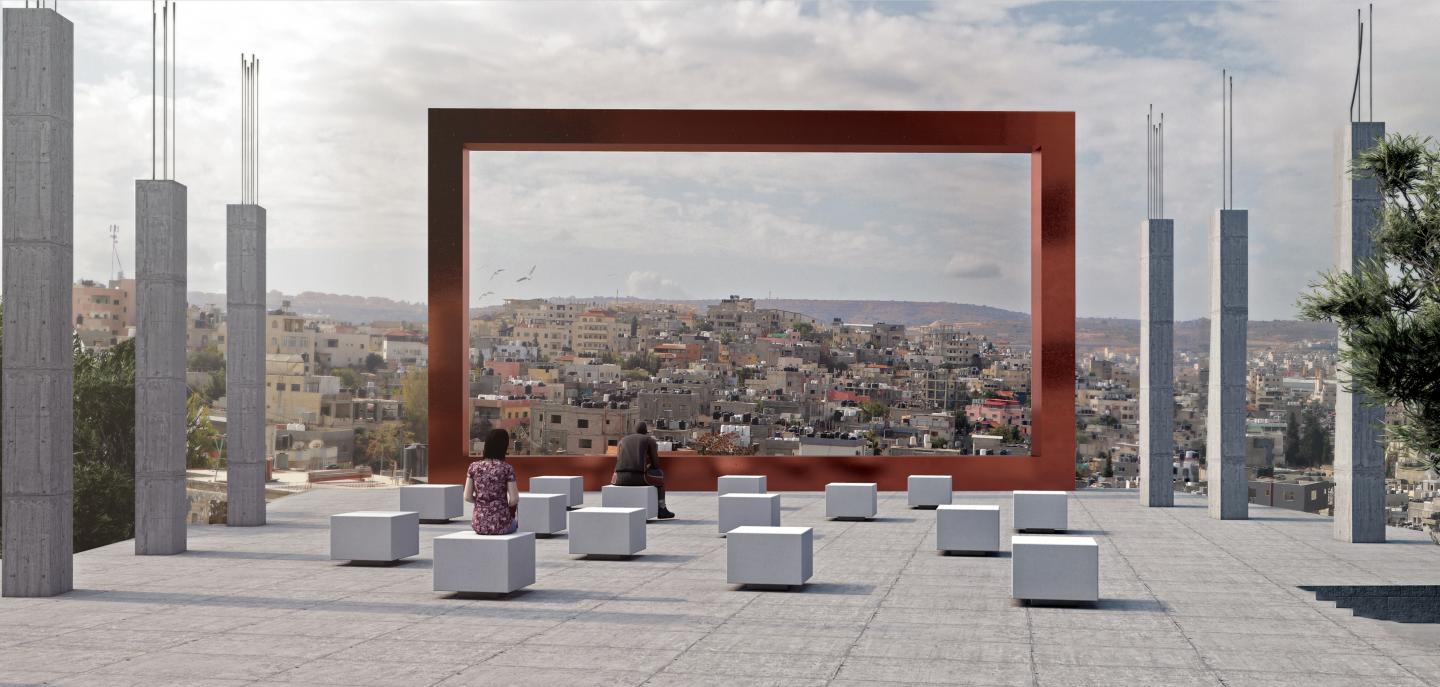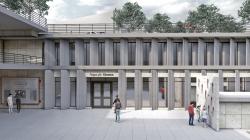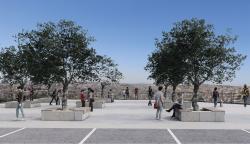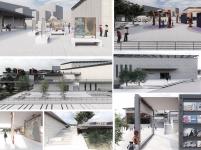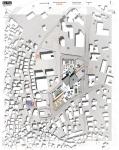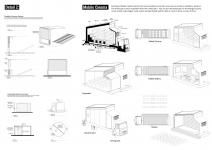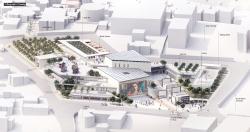Beyond the drawn lines:
"If we don't tell our story, who would?".
The project discusses the idea of image war and cinema as a force of change. The image in our current age, the age of technology, is very efficient in creating meanings and moral values, promoting ideologies, excluding oppression and marginalization. This image, whether it was movies or series, television programs, or even which all of it is called the seventh art.
Cinema as a tool:
The project sheds light on both the social and political aspect in which cinema can help optimize, The project tries to answer the question whether it is possible to gain freedom and help liberate occupied societies by using cinema and architecture. A variety of international experiences have been deduced in the use of cinema as a tool:
1) The experience of the Bolshevik Revolution cinema in getting rid of the rule of the Tsar. 2) Hitler's media campaign to lead his country to destruction in World War II.
3) The experience of South African cinema in getting rid of the apartheid of European colonialism.
4) Finally, the Zionist cinema experience in the occupation of Palestine. Accordingly, it was assumed that cinema in Palestine is a necessary societal need, not just a recreational one.
Architecture Speaks Through Cinema:
Mobile Film , Film Lab , Film Library
The project represents a series of “cinematic spaces” in the city of Bethlehem, Palestine. Aiming to enrich the cinematic culture and to mirror the Palestinian stories of marginalized areas audio-visually. Empowering a new generation of pioneers, YouTubers, influencers, and Local filmmakers to show and tell their experiences to local and global audiences. These spaces are divided into 3 main functions:
1) Community Cinema: To ensure the project's independence from any agenda. The community in general was involved with interactive exhibition spaces, including an open-air cinema, a "mobile cinema" to attract pioneers and spread the culture of cinema in marginalized areas. An external exhibition showing the history of Palestinian cinema and public squares that accommodate the Camp Film Festival or the Schools Film Festival, for example, where the films of the people they have produced are shown.
2) Community Film Production: It aims to help people make their own film production. It has more than one level of users, pioneers, YouTubers, influencers and local film makers. They form an integrated and continuous cycle in enriching each other's experiences. Pioneers can contribute in acting and directing, an idea, writing a coherent script, using people's voice in animation or dubbing, borrowing tools and shooting equipment. Uploading video clips filmed on the phone and sent to a proofreader and audio and video processor.
These digital stories made in film labs will be promoted via social media by influencers and YouTubers in exchange for providing them with architectural spaces such as the use of outdoor and indoor displays, theater to speak through, lecture hall for discussion, capacity building workshops in the subject of film production. As for the local filmmakers who graduate from Dar al-Kalima University, which is located next to the project site, they enrich the cinematic content of ordinary people. Consequently, there is a cinematic material that clearly faces any persecution and marginalization, whether societal or political, with the least human or technological resources.
3) Cinematheque: is a digital library of archive films and film-related objects with the venue of the exhibition, and is responsible for preserving the general cinematic heritage. It includes the cinematic works of all Palestinians from the occupied interior (the Palestinian territories occupied in 1948), the diaspora, the West Bank and Gaza. The Cinematheque works on digitization and certain processing with international standards. Including the films before the 1948 Nakba and the films of the Palestinian revolution cinema, which were distinguished by their low cost and external studios. Cinematheque allows films to be a cultural exchange between peoples and also to show them to local audiences.
Vis-à-Vis Relation:
Dehisha Refugee camp , Bethlehem City center
The project serves as a recreational urban space for the local population, linking the Dheisheh refugee camp and the city center of Bethlehem.
Due to the architectural and social introversion of most of the neighboring buildings in the area, since they are fenced by walls and small gates for people to only reach into educational, governmental and cultural institutions without any kind of interaction with the surroundings, unlike the camp’s architecture, there is an absolute openness to the street space where you find children playing in the street and laundry hanging across the windows, we find a person with his family on the edge of the road, drinking a cup of tea. This contrast between this part of the project’s surroundings and that, the architectural treatment came to create balance in terms of giving the camp side its privacy by planting tree fields and liberating the center side from being closed by creating open yards towards it without restrictions.
In addition to strengthening the relationship with the surroundings and integrating the neighboring spaces, a waiting station was created near the Ahlia University and additional parking was provided (as the Ahlia University does not have its own parking). Choosing fruit trees (a net of grape trees, orange orchards, and olive trees) is an opportunity to invest with the "Central Market" center, which is distributed to all accounts in Bethlehem, and these agricultural crops are commensurate with the nature of the soil of Bethlehem's land, which is famous for these varieties.
Cinema in Bethlehem:
In 2021, the city of Bethlehem was classified as the Capital of Arab Culture, but it does not have any cinemas or an official cinema centers, despite the cultural and religious diversity and Bethlehem's embrace of the only Palestinian university that teaches cinema, which is the University of "Dar Al Kalima", which is located next to the project site.
Films were shown in creative ways in various areas in Bethlehem by independent individual youth initiatives, such as “Stair Cinema, which revived Salesian Street in the Old City, the cinema of the apartheid wall in Aida camp, the camp cinema in Dheisheh camp, Street Cinema and School cinema The popular cinema has received wide interaction among people, but it is on a limited and temporary level, thus becoming “the belief that cinema is a right for everyone and not only for the elite, and that we can be producers and directors through the lens of mobile phones.”
Mobile Cinema:
The creation of a flexible mobile cinema that can fit multiple purposes such as a cinema, an exhibition or even a theater. The static part(Drive) can be separated from the dynamic part (Cinema, Theater,Gallery). The mobile cinema goes to areas identified according to the study of marginalized areas in Bethlehem, such as the refugee camps, Rachel's Dome at the Segregation Wall, and the Old City. In addition, a series of films were shown over several days in Manger Square, in the schoolyard, in refugee camps, on the streets, and on the apartheid wall. The mobile cinema operates while on the project site, where it can be used to show films made by amateurs.
Interior Film Lab:
Sliding curtain track system is the main defining element of the interior space, the system basically is made of ceiling curtain track, unlike most film studios where curtain tracks are hidden, the sliding track is very vital in the interior space, this track supports many different types of curtains that are used as flexible acoustic dividers for the interior space, these curtain dividers can be used to create 3 different functions in the same space, the space can be turned into a studio for the production of social films (social film production), or a cinema, or even a space of discussion | Yoga.
2022
2022
Location: Bethlehem, Palestine.
Area: 18 dunam.
Student: Lena Lahalih
Supervisor: Ehab Al-Afandi
Favorited 2 times
